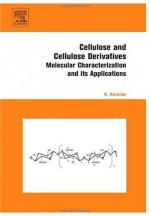|
This section contains 405 words (approx. 2 pages at 300 words per page) |

|
Cellulose is a complex carbohydrate that is a primary constituent of plant cell walls. It occurs in both primitive and highly evolved plants. Cellulose comprises about 20-30% of primary cell walls and about 40-90% of secondary cell walls. It is the world's most abundant organic compound. The biological function of cellulose is thought to be skeletal, providing shape and strength to the cell wall. Cellulose differs from other polysaccharides found in plants by consisting of molecular chains that are very long, by containing only one repeating glucose subunit, and by occurring naturally in a crystalline state. The glucose subunits are connected by beta linkages. Most mammals, including man, do not have enzymes capable of promoting the hydrolysis of this beta linkage, so cellulose passes through the digestive tract unchanged. However, microorganisms found in the digestive tracts of herbivorous animals (especially in ruminants (cud-chewing animals)) can break down cellulose...
|
This section contains 405 words (approx. 2 pages at 300 words per page) |

|


